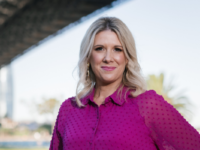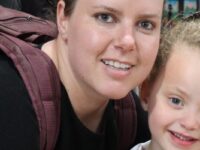We talk with Jerry Farsoun, whose innovative app utilises the latest technology to help locate lost children.
Jerry Farsoun is the creator of Leelou, a peer-to-peer “SOS” platform that connects young people with their guardians and uses GPS technology to enable people to locate each other in an emergency.
After a terrifying incident in which his toddler got separated from the family on an outing, Jerry developed an integration between his platform and smart glasses, which leverages technology to “find” lost children.
ISB: What was the “lightbulb moment” behind you developing your platform that integrates with smart glasses?
JF: A couple of years ago I lost sight of my two-year-old son while we were riding our bikes as a family at Federation Square. I couldn’t work out where we lost him and proceeded to lose my mind. Looking around at the CCTV cameras, I thought that’d be the best way to find him but had no luck working out who to talk to, to access the cameras.
Then smart glass technology appeared in a news feed and it occurred to me that this could ultimately be a game changer in locating missing children. If we all, or just some of us, had smart glasses, I could upload my missing child’s profile to an app, and potentially have them found much faster through the collective effort of the smart glasses “community”.
ISB: And please tell us what the platform does and, in layman’s terms, how it works?
JF: Prior to going out, you upload your children’s profiles – name, date of birth, age, and features about them such as height and hair colour. A close-up facial recognition picture and full back and front shots showing what they are wearing are saved onto the Leelou app.
“I’ve always had a diagnostic mind … and never gave up as a motor mechanic to resolve an issue. This has helped in many areas of business.”
If a child goes missing you submit their profile to the platform and the face recognition profile is pushed out to the glasses network to start scanning everyone the glass wearers pass. Once the child is recognised, the Leelou Private Eye operator is notified and calls the owner of the glasses who sent out the SOS. After verification via pre-arranged “safe words” the child can be reunited with their parents/guardians.
It also works at public events: if a user presses the SOS button, the SOS goes to the event security office (we call it the NOC – national operations centre) and they ask what the issue is. In a lost child case, the user (parent or guardian) would have their child’s profile in their Leelou app called the Vault, and upload that profile to the NOC, who push the child’s face recognition profile out to the security guards to start instantly scanning the audience for the child.
ISB: What was the biggest challenge you faced in getting the enterprise off the ground?
JF: First, it was learning the technology. Then, finding good people who believed in my vision and had the skill set to execute it. It was easy making anyone fall in love with Leelou and its vision, it’s pretty self-explanatory, but as a founder, being “suckered” into having faith in them because of that enthusiasm cost a me fortune. I could rebuild the entire platform in a quarter of the time and cost, but there’s no point in crying over spilt milk, right?
ISB: You’re a mechanic by training – who translates your ideas into reality?
JF: I’ve always had a diagnostic mind, loved solving problems and never gave up as a motor mechanic to resolve an issue. This has helped in many areas of business and life. So, when I’m confronted as a founder with technology, I ask questions, listen and store the information.
When speaking to others on the same topic, I started to learn the lingo and what some of the tech meant. In the hope of getting myself to a point where I could realise my vision I studied to be an MCSE (Microsoft Certified Systems Engineer) and I am an MCP (Microsoft Certified Professional). I thought that these qualifications would teach me the fundamentals of computers and programming, but it turned out to be more about the hardware than the software.
However, I met many people in the computer and IT industry and learned enough to get started. I just had to wait until the cost of technology became affordable and viable enough to achieve what I envisioned for Leelou – the platform was born in 2008, and I learn every day from my Melbourne-based teams about the secrets of coding and programming.
ISB: I understand there’s a reward system for those who help to locate a missing person – could you tell us a little more about that?
JF: I liken it to Uber CCTV. A parent like myself can pay a nominal fee and upload a missing child, and once the child is located and verification process completed, a percentage of the fee is split so the owner of the glasses who located the child receives financial compensation for their investment in the platform. Technology isn’t cheap, and to help build the army of Leelou Private Eyes the reward is an additional incentive for people to join the community helping make children safer.
ISB: How do you see the platform developing in the next couple of years?
JF: It’s still early days but I see wearables – or smart-glass technology – being something that many of us will have. When mobile phones came out, we never thought of having earpieces and when we first did, they were tethered; then wireless headphones became a thing and we were able to have two hands free while driving or working away at our desk.
As technology evolves, IoT devices are becoming more and more in demand – voice activation, smart homes, more wearables and even safety devices for the elderly that have biometrics in them. Smart glasses are an evolutionary part of the process, leveraging, for example, Google’s Active Translator so you can have the app running in a foreign country and see the translation of road signs or shopfronts translating via text or audibly through Bluetooth ear pieces.
I believe hands-free translation and facial recognition will become part of everyday life in the coming years and will be seen as “necessary evils” that people will realise add incredible benefits to their lives.
This story first appeared in issue 27 of the Inside Small Business quarterly magazine.
















